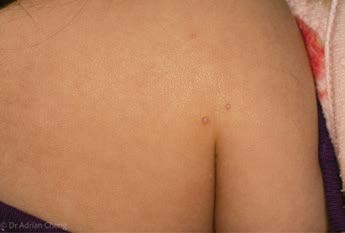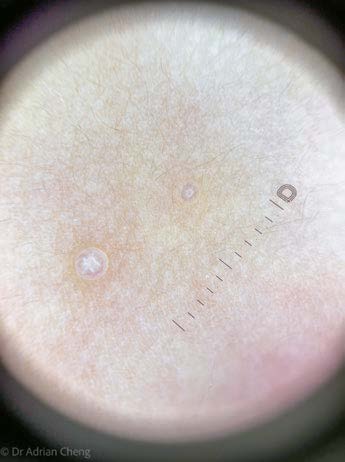Research & Publications > The Hong Kong Practitioner > Clinical Quiz

Clinical Quiz (Please login 'Member Area' for online submission of latest issue)
Clinical Quiz March 2025
A 16-month-old girl developed skin coloured papules
over her arms and back for 2 months
Dr. Adrian KC Cheng
|
Readers are invited to participate in the Clinical Quiz*. Simply answer the question, fill in the reply slip and return it to the College by 22 May 2025. Each reader is allowed to submit one entry only.
*Note: There would be no prize award for this issue while sponsorship for Clinical Quiz has been ended in September 2020 issue. The answer of the Clinical Quiz for this issue will be announced in the next issue. Thank you for your support.
|
Clinical history:
A 16-month-old girl developed skin coloured papules
over her arms and back for 2 months. Examination of the papules showed central
umbilication. Dermoscopic view showed translucent papules with whitish
amorphous structure, central umbilicated core, and surrounding telangiectasia
in a crown pattern.
What is the diagnosis?



| A. | Viral warts |
| B. | Keratoacanthoma |
| C. | Molluscum contagiosum |
| D. | Chickenpox |
Answer:
C. Molluscum contagiosum
Molluscum contagiosum is a common cutaneous viral infection caused by a poxvirus, Molluscum contagiosum virus. It primarily affects children between 1 and 10 years of age, particularly those with atopic dermatitis due to a compromised skin barrier and suppressed Th-cell responses. Transmission occurs through direct skin-to-skin contact, fomites (e.g. towels, toys), and autoinoculation by scratching.
Clinically, molluscum contagiosum presents as pearly, flesh-coloured to pink, dome-shaped papules that often appear translucent. The central depression or umbilication may or may not be evident. Dermoscopy may aid in identifying central umbilication with arborizing telangiectasia or telangiectasia in a crown pattern. In doubtful cases, histology reveals molluscum bodies (Henderson-Patterson inclusion bodies) within keratinocytes.
Single lesions may occur. Molluscum contagiosum most often presents with clustered or linear papules resulting from autoinoculation. Lesions may develop significant erythema before spontaneous resolution which represents a host immune response against the poxvirus.
Management is often conservative, given the self-limiting nature of the infection. Spontaneous resolution oftens occurs over years, with an average time ranging between 6 and 16 months. Parents and patients may request treatment for pruritus, cosmetic or epidemiological concerns. Treatment options include physical destruction such as curettage or cryotherapy, however this may not be tolerable in young children. Cantharidin, an extract from the blister beetle, is effective and well-tolerated in children, but its availability is limited in Hong Kong. Other topical treatments include imiquimod cream, tretinoin cream and salicylic acid.
Parental education is essential to reassure about the benign course and to minimise transmission. Hand hygiene, avoidance of sharing towels and clothing, covering lesions, and avoid scratching are recommended.
The slide and the question were prepared by:
Dr. Adrian KC Cheng, MBBS(HK), MRCP(UK), MSc GEOR (CUHK), FHKCP, FHKAM (Medicine)
Specialist in Dermatology & Venereology;
Associate Consultant,
Division of Dermatology, Department of Medicine, Queen Mary Hospital, Hong Kong SAR
Back


